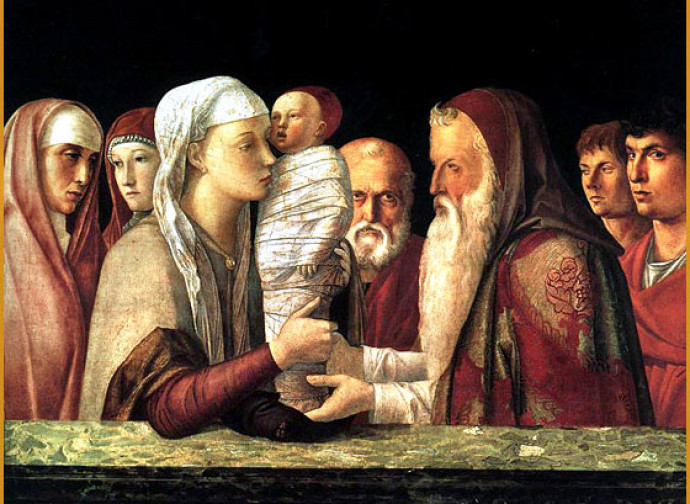Presentation of the Lord
The feast of the Presentation of the Lord concludes the Christmas celebrations by recalling that, 40 days after His birth, Jesus was taken to the temple by Mary and Joseph.

The feast of the Presentation of the Lord concludes the Christmas celebrations by recalling that, 40 days after His birth, Jesus was taken to the temple by Mary and Joseph. Besides fulfilling the Law of Moses, this was Jesus' encounter with the faithful, symbolised by the prophets Simeon and Anna, who were awaiting the promised salvation. After the Divine Child had been manifested to the humble shepherds of Israel and then to the pagans in the persons of the Magi, the Presentation of Jesus in the temple (Lk 2: 22-39) prefigured the suffering which would accomplish man's Redemption.
The Passion of the Son is actually foretold in the words addressed by Simeon to Mary: "Look, he is destined for the fall and for the rise of many in Israel, destined to be a sign of contradiction, and a sword will pierce your soul too – so that the secret thoughts of many may be laid bare." Simeon's words anticipate the mystery of Christ, the link between the Old and the New Covenant that would fulfil the ancient promise of salvation through His sacrifice on the cross. While the firstborn males of Israel, in remembrance of the liberation from Egypt, were offered to God but redeemed by a small sacrifice (cf. Ex 13: 2-12; Lev 12: 1-8), Jesus, obedient in everything to the Father's will, is the only Firstborn not to be spared, to offer true liberation from sin and death through His blood.
The prophecy of Simeon, the first of the traditional "Seven sorrows" included in the cult of the Virgin of Sorrows, also presents the communion of the Mother with the suffering of the Son, "under Him and with Him [...] serving the mystery of redemption." (Lumen Gentium, 56). Hence, Mary's title as Co-Redemptrix, expressing her special cooperation in the saving mystery of the one Redeemer, Jesus Christ.
It should also be remembered that before the liturgical reform of 1969 this day was called the "Purification of the Blessed Virgin Mary", a name kept in the extraordinary form of the Roman Rite, which highlights Mary's total obedience to the divine Will up to the offering of her beloved Jesus: the Immaculate Conception and All Holy, in whom there was nothing to purify, still, as the humble daughter of Israel, did observe the Mosaic law. Therefore, the two names of the feast shed light on each other, highlighting the inextricable link between the mysteries of the Son and His Mother.
Today's feast, popularly known as Candlemas, originated in the East with the Greek name of Hypapante, which means "encounter", alluding to the meeting between Simeon and Jesus. As the old prophet took the Child in his arms, by the grace of the Holy Spirit he recognised Him as the awaited Messiah, and broke into a beautiful song: "Now, Master, you are letting your servant go in peace as you promised; for my eyes have seen the salvation which you have made ready in the sight of the nations; a light of revelation for the gentiles and glory for your people Israel".
The feast later spread to the West, where the oldest Roman penitential procession was introduced under the pontificate of Saint Sergius I (687-701) from the church of Sant'Adriano al Foro to that of Santa Maria Maggiore. The earliest trace of the ritual of the blessing of candles (hence the name Candlemas) goes back to the 10th century. A "light of revelation": thus Simeon referred to the Divine Child, whom we are all called to take in our arms and welcome in our hearts, while awaiting the eternal reward.




